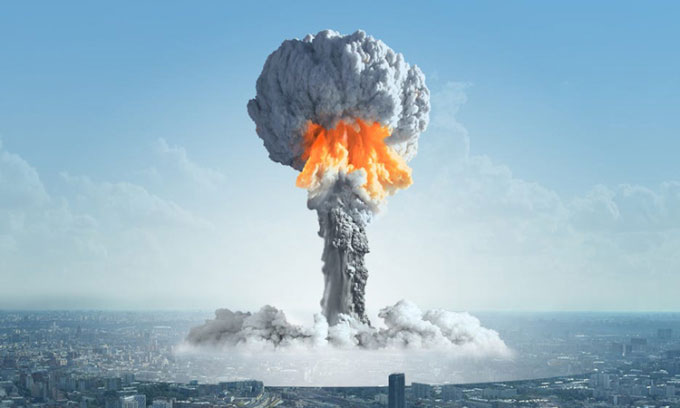What happens if a 300 kiloton nuclear bomb is detonated?
Nuclear bombs are not only destructive on the ground, but also blow deadly radioactive dust tens of kilometers into the atmosphere.
According to the Federation of American Scientists, the United States has about 5,500 nuclear weapons, while Russia has about 6,000. "Modern weapons are 20 to 30 times more powerful than the bombs dropped on Hiroshima and Nagasaki. If the US and Russia detonated all they had, it could be a civilization-ending event," Drozdenko said. added.
When a nuclear bomb explodes, it creates a flash of light, a giant orange fireball, and spreading shock waves. People in the center of the explosion (within half a mile of a 300-kiloton bomb) could be instantly killed, while those in the vicinity could suffer third-degree burns.
According to an estimate from AsapScience, a 1,000 kiloton nuclear explosion can cause 3rd degree burns up to 5km away, 2nd degree burns 6km away, and 1st degree burns up to 7km away. People who are 85km away may also experience temporary blindness.

Simulate nuclear bomb exploding in a big city.
Nuclear explosions also create clouds of dust and sand-like radioactive particles that are released into the atmosphere - known as nuclear fallout. Exposure to this dust can lead to radiation poisoning, damage to the body's cells, and even death.
Dust clouds can block sunlight, cause temperature drops and shorten the growing season of essential crops. Crop yields can drop dramatically for decades, leading to famine in many places, Drozdenko said.
If a 300 kiloton nuclear weapon hit a city the size of Washington DC, many residents would not be able to survive. People nearby will also face serious injuries.
"A lethal dose of radiation would cover most of the city and a little bit of Virginia. The heat radiation, the heat, would go to parts of Maryland, a little further to Virginia, and all the people. in that area will get 3rd degree burns," Drozdenko said.
Experts estimate that a single nuclear bomb could kill about 300,000 people in the Washington area and injure many more. Depending on the number of bombs dropped and the destructive power of the explosions, the number of people killed could be in the millions.
"The larger the weapon, the larger the damage radius," added Drozdenko. The destructive power of a nuclear bomb also depends on how it is detonated.
If the weapon hits land, the explosion will create more fallout from dirt and other materials being thrown into the atmosphere, but if a country detonates the bomb mid-air, the shock waves reaching the ground will bounce off and amplify each other, resulting in much greater destructive power. This "airborne explosion" could also send radioactive material up to 80km high into the atmosphere, according to the Environmental Protection Agency.
Nations rely on simulations and weapons testing to predict these effects, but it is difficult to know what a modern-day nuclear attack would look like in real life.
"There is no historical precedent for this," Drozdenko added. "The only time nuclear weapons were used in a conflict was World War II."
- The most powerful thermonuclear bombs in the world
- Super nuclear bomb has the most explosive power in the world
- Disaster when detonating the most powerful nuclear bomb in the universe
- Inside the machine recreates the nuclear bomb and the black hole Universe is located in Mexico
- The United States announced hundreds of videos of top secret nuclear bombs
- The object was amazingly intact after the atomic bomb explosion in Hiroshima
- Explore America's superior nuclear bomb shelter
- Decipher the mystery where the US built an atomic bomb
- Strange cloud of nuclear bomb explosion appeared in Russia
- The fate of the island tried 23 nuclear bombs
- Lessons from Japanese nuclear disaster
- How is the moon almost bombed?
 'Fine laughs' - Scary and painful torture in ancient times
'Fine laughs' - Scary and painful torture in ancient times The sequence of numbers 142857 of the Egyptian pyramids is known as the strangest number in the world - Why?
The sequence of numbers 142857 of the Egyptian pyramids is known as the strangest number in the world - Why? History of the iron
History of the iron What is alum?
What is alum?